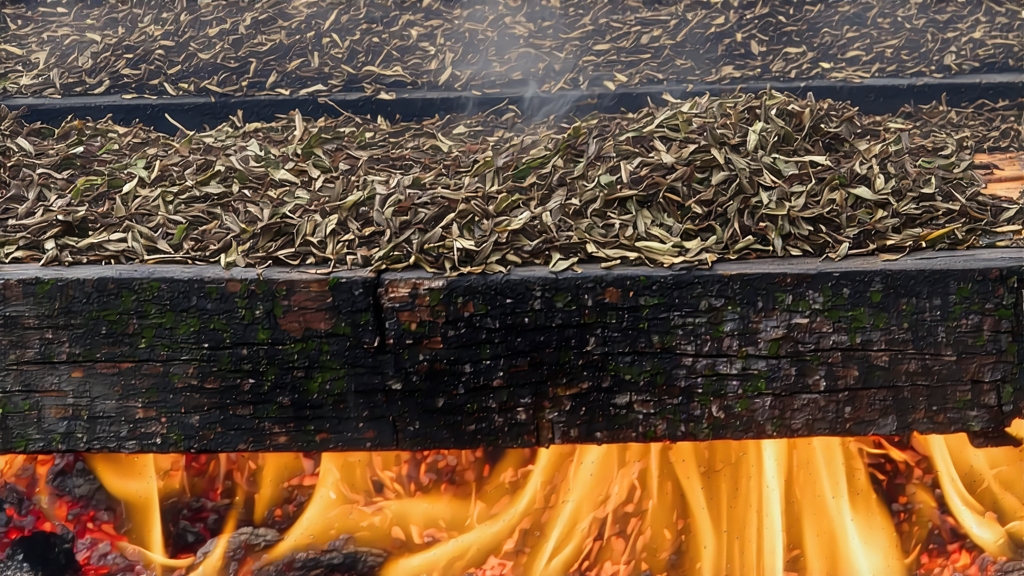
When European tea drinkers first encountered the dark, twisted leaves that produced a liquor the color of claret in the early seventeenth century, they were tasting Lapsang Souchong—long before Assam, Ceylon, or Keemun ever reached the market. Hailing from Tongmu village, a protected enclave deep in the Wuyi Mountains of Fujian province, this tea is not merely a style; it is the primogenitor of all black teas. Its Chinese name, zhengshan xiaozhong, literally means “small-leaf variety from the original mountain,” a nod to the indigenous tea bushes that have grown among the granite cliffs and mineral-rich streams for over a millennium.
Legend credits its birth to an accident of war. In 1646, Qing soldiers were said to have quartered themselves in tea workshops during the transition from Ming loyalist resistance. To dry the leaves quickly for the advancing army, workers spread them over pine fires. The smoke penetrated the leaf, creating an entirely new aroma that proved wildly popular with the Dutch traders waiting at Xiamen port. Whether myth or marketing, the story underscores a pivotal moment: China had invented oxidation, and the world had acquired a taste for it.
Today, Tongmu is a UNESCO Man and Biosphere Reserve; every kilo of authentic Lapsang Souchong is tracked by satellite and sealed with a government-issued anti-counterfeit code. The microclimate is crucial: 96% humidity, average annual temperature of 12 °C, and acidic soil laced with quartz. Only six natural villages inside a 53 km² core zone may legally produce the tea, and picking is restricted to late May, after the azaleas have bloomed and the mountain mist is thickest.
Two distinct styles now coexist. The traditional “smoked” grade is withered over embers of local Masson pine, whose resin imparts a fragrance reminiscent of single-malt whisky and dried longan. After rolling, the leaves are placed on bamboo trays above slow fires for eight to ten hours, absorbing phenols that later bond with theaflavins to yield a sweet, cooling finish. The newer “unsmoked” or “craft” grade, developed for the modern Chinese palate, omits the pine phase and relies entirely on precise oxidation in bamboo baskets heated only by charcoal. The result is a lighter, malt-honey liquor that showcases the cultivar’s natural lychee note while still bearing the mineral backbone of Wuyi terroir.
Leaf grading follows an idiosyncratic local code:
- Pekoe (one leaf and a bud) becomes “Xiaozhong”
- Two leaves and a bud, the classic “Souchong”
- Larger, more mature leaves are “Congou,” reserved for blending
Only the top 15% of each harvest meets the strict “zhengshan” designation; the remainder is sold as “waisahan” (outside mountain) and often finds its way into flavored blends labeled merely as “black tea.”
To brew Lapsang Souchong gongfu style, begin with soft water brought to 95 °C. Use 5 g of leaf in a 120 ml gaiwan. Rinse once to awaken the leaf, then steep 5 s, 10 s, 15 s, adding 5 s each subsequent infusion. The first cup releases a burst of pine and camphor that quickly yields to cocoa and ripe plum. By the third steep, the smoke recedes, exposing a rock-sugar sweetness and a lingering hint of cinnamon bark. A good leaf will deliver eight infusions; the final one can be boiled in a clay kettle to extract every trace of resinous perfume.
Western methods are forgiving: 2.5 g per 250 ml, 4 min at 90 °C, though the smoke can overpower if over-steeped. Many British tea firms once used Lapsang as a base for Russian Caravan, but purists now recommend drinking it neat, preferably from a porcelain cup to avoid any competing aromas.
Pairing food with smoked Lapsang is an adventure. Its phenolic profile cuts through the fat of smoked salmon or aged Gouda, while the sweet finish complements dark-chocolate truffles. In Fujian, locals sip it alongside youtiao (fried dough) at breakfast, claiming the pine notes neutralize oil. Unsmoked versions marry beautifully with fresh lychee or a mild goat cheese, allowing the tea’s natural fruitiness to echo the food’s sweetness.
To evaluate quality, first